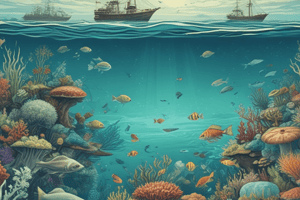Podcast
Questions and Answers
What percentage of the Earth's surface is covered by oceans and seas?
What percentage of the Earth's surface is covered by oceans and seas?
- 70% (correct)
- 30%
- 90%
- 50%
The Pacific Ocean is the smallest ocean on Earth.
The Pacific Ocean is the smallest ocean on Earth.
False (B)
Name one way in which oceans serve as a food source for the world.
Name one way in which oceans serve as a food source for the world.
Fishing or aquaculture
Oceans have an average depth of around _________ meters.
Oceans have an average depth of around _________ meters.
Match the following features with their definitions:
Match the following features with their definitions:
Which ocean extends up to 60° South latitude?
Which ocean extends up to 60° South latitude?
Seas are generally deeper than oceans.
Seas are generally deeper than oceans.
What is a major threat facing oceans today?
What is a major threat facing oceans today?
Flashcards
Ocean vs. Sea
Ocean vs. Sea
Oceans are vast bodies of saltwater; seas are smaller bodies of saltwater, often located within or near oceans.
Pacific Ocean Size
Pacific Ocean Size
The largest ocean, covering approximately 45% of all ocean surface area.
Ocean Importance
Ocean Importance
Oceans support essential ecosystems and regulate the Earth's climate.
Ocean Depth
Ocean Depth
Signup and view all the flashcards
Marine Biodiversity
Marine Biodiversity
Signup and view all the flashcards
Ocean Currents
Ocean Currents
Signup and view all the flashcards
Threats to Oceans
Threats to Oceans
Signup and view all the flashcards
Ocean as Food Source
Ocean as Food Source
Signup and view all the flashcards
Study Notes
Oceans and Seas
- Oceans and seas cover more than 70% of Earth's surface, containing 97% of its water.
- They have crucial environmental roles, supporting ecosystems and influencing climate.
- Oceans are larger bodies of saltwater, with average depths of around 3,700 meters (12,000 feet) or more.
- Oceans have a greater diversity of marine life than seas, including fish, mammals, reptiles, and other aquatic animals.
- Seas are smaller bodies of saltwater, located within or near oceans.
- Seas tend to have average depths less than 1,000 meters (3,300 feet).
- Seas typically have fewer marine species, such as fish, crabs, lobsters, shrimps, and shellfish..
The Pacific Ocean
- The Pacific Ocean is the largest ocean, covering approximately 45% of the total ocean surface area.
- Its area is over 165 million km².
- Its boundaries encompass North and South America, East Asia, Australia, and the Southern Ocean (at 60° South latitude).
- It contains diverse islands, from Polynesian atolls to larger landmasses such as Japan and New Zealand.
Studying That Suits You
Use AI to generate personalized quizzes and flashcards to suit your learning preferences.



